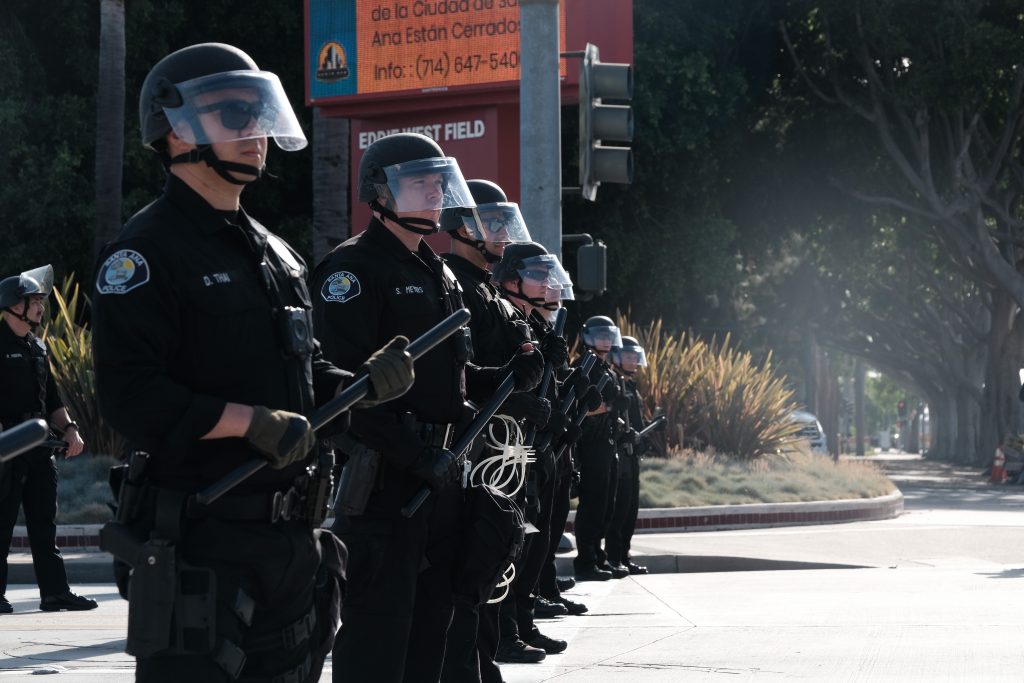Police violence is once again dominating the national discourse. Though George Floyd was murdered hundreds of miles away, the same structural injustices that made officer Derek Chauvin feel protected enough from any consequences to take George’s life even as cameras filmed, permeate the entire country, from large metropolises to small towns, and places in between like Santa Ana.
The city of Santa Ana is well acquainted with police violence. Just last month, a video of two officers appearing to brutalize and harass an older man made the rounds on social media. City officials and the Police Department have yet to respond to the incident involving officers Bradley Sharp (#3327) and Ryan Bell (#3517), and body camera footage of the incident is not yet available to the public. Attempts to address the incident internally with the department will likely lead nowhere, and the family of this man will no doubt need to seek legal action.
Leading up to the latest set of events that place policing and police oversight at the top of the city’s (and nation’s) attention, came a 2019 series of police scorecards created by Campaign Zero (2), an organization supporting efforts to end police violence through research and data analysis. These scorecards rank 100 of the largest police departments in California and give them a grade on criteria like incidents of police brutality and cost per-year per-taxpayer to fund police departments.
For those of us who’ve been paying attention for years it’s no surprise that Santa Ana Police Department (SAPD) received the worst possible score. In receiving an “F” grade, SAPD ranked 92 out of 100 departments, putting it amongst the worst in the state.
Violent encounters with SAPD are not uncommon, nor are the growing number of lawsuits that have been filed against the department over the last couple of years, along with the millions of dollars in settlement payments the city council has approved while pretending we don’t have a problem.
Police departments on the scorecard were graded on three benchmarks of policing: police violence (deadly force incidents), police accountability (the extent to which officers were held accountable), and approach to policing (whether departments’ priorities were arresting people with low level offenses or solving serious crimes). The three areas were combined to give agencies their final grade.
Below are some of the stats and grades for each category that landed SAPD its failing grade:
Police Violence: F (28%)
- Santa Ana had 13 deadly force incidents, higher than 70% of all police departments. There was a severe increase of police using other weapons including batons and strangleholds, a high peak of 122 cases in 2018.
- Although police claim they saw a gun, 17% of guns “perceived” were never found.
- In the 13 police shootings, 69% of the time, police did not attempt non-lethal force before shooting.
Police Accountability: F (6%)
- Of the 108 complaints filed, only 2% ruled in favor of civilians, 1 in every 54 complaints.
- 0% of complaints involving use of force, police discrimination, and alleged crimes comitted by police ruled in favor of civilians.
Approach to Policing: D (69%)
- SAPD made 21,219 arrests from 2016-2018. Santa Ana had a lower misdemeanor arrest rate than 86% of police departments.
- Of the 108 homicides that occurred between 2013-2018, 52 were unsolved. SAPD solved fewer homicides than 79% of other departments.
- 62% of homicides victims unsolved were Latinx.
- Policing in 2018 took an upward of 24% of the city’s budget. This was at a cost of $380 per resident.
These appalling statistics are the result of a legacy of inaction going back decades to 1965, when Orange County Congress of Racial Equity first proposed the creation of a police oversight board. Today, they are part of Mayor Miguel Pulido’s legacy, who will term out of office after 30 years of inaction, and the rotating group of City Council members that refuse to hold our police department accountable, most of whom were recently elected with hundreds of thousands of dollars in election expenditures by the Santa Ana Police Officers Association (SAPOA).
Police Departments who scored higher were ones who did not use deadly force and had a high percentage of cases ruling in favor of civilians. The Tracy Police Department for example, did not use deadly force from 2016-2018 and had no unsolved homicides. This is the result of policies Tracy has that require officers to give warnings to shoot and also require them to intervene when witnessing excessive force.
In the wake of the last two weeks of protests the conversation is once again turning toward police accountability, and just as importantly, an honest conversation among residents about the unequal distribution of our city’s budget toward police and policing.
Just today, Council Members Phil Bacerra and David Peñaloza agendized an item on the June 16 City Council agenda to direct city staff to research the creation of a Police Oversight Commission. On a different year, on a different month–hell, on a different day this would’ve been just swell. But staff have been directed to research the issue before, most recently in 2017 when then Council Member Michelle Martinez broached the topic. Residents have been calling for police oversight since 1965.
At minimum, this moment calls for a clear commitment on the part of city Council Members to enact police oversight, to outline their own principles for what oversight should look like, listen to the input they’ve received in the hundreds of public comments and emails of the last week, and proceed in good faith to build a police oversight commission with teeth.
References:

Bulmaro "Boomer" Vicente
is a Soros Justice Fellow with Chispa. He is a Latinx scholar, writer and organizer from Santa Ana. Boomer studied Political Science and Public Policy at UC Berkeley. He has worked on issues surrounding police accountability and housing justice. His work has been featured on NPR, East Bay Express, Breibart (lol), Sacramento Bee, and other outlets.



